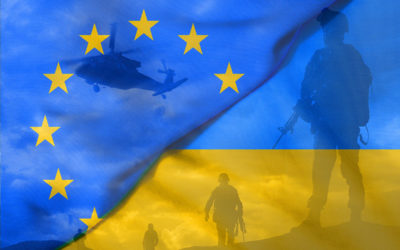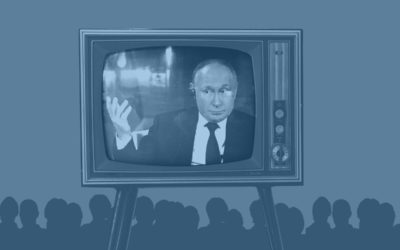Russia’s War Against Ukraine is at a Pivotal Junction – It’s Time for the EU to Decide if it’s all in
16 February 2023

As the war in Ukraine approaches its disheartening one-year mark, much has changed in terms of its outlook and our own perceptions. While leading experts predicted a swift capitulation of the government, Ukraine’s quintessential bend-but-don’t-break resilience has given rise to hope and opportunities. But this has come at a tremendous cost.
Since the launch of the invasion, the loss of life on both sides has been staggering. The U.S.’s top military advisor, Gen. Mark Milley, has estimated that both Russia and Ukraine have lost around 100,000 soldiers each, in addition to roughly 40,000 Ukraine civilians, with mass graves and other horrors being discovered regularly.
Of course, in addition to the Ukrainian people’s awe-inspiring sheer will for freedom, impressive ability to quickly learn and wage combined warfare, it is Western armaments that are making the profound difference, most notably from the United States and the UK.
While the European Union reacted with notable speed and unison (especially by EU standards) and perhaps, somewhere along the way, coming just a little bit closer to defining the age-old riddle of “what is European identity?”, the war would be long lost if not for the military support for Ukraine from the outside world. Reflecting on this, the EU needs to realise that this very moment is pivotal in the war. It needs to invest in its own security by way of investing in and securing Ukraine’s victory, at whatever cost.
To date, the U.S. has pledged and delivered over 25 billion euros to Ukraine in lethal aid. The UK by comparison, the second-largest single donor, has committed 2.6 billion euros to date. The European Union however, a collective of 27 countries, has committed only 3.6 billion, despite its immediate proximity to the conflict and boasting of being the world’s largest economy.
The latest saga that especially underlines this unbalanced dichotomy is the months-long debate and final agreement to send tanks. Was it monumental for the EU? Absolutely! But that achievement still has many caveats, most of all being that the actual final arrival of those tanks won’t be for months and will require at least 6-8 weeks of training. Meanwhile, there are already signs of weakening, or the watering down of those pledges, most notably by the Netherlands and Denmark who announced that they will not send Leopard 2’s, all while France remains completely absent on the question of sending its own tanks. It seems that, once again, the EU is moving at its steady pace of two steps forward, one step back.
The timeline for those tanks and other heavy weapons systems means that Ukraine won’t have this firepower to assist in Russia’s imminent spring offensive, at least in the numbers needed to make an immediate impact, and could also predicate Ukraine’s ability to counter Russia and launch its own planned offensive.
We are at a point in this war where we are taking Ukraine’s relative success for granted. Yes, Bakhmut holds (for now – but not likely for long) and Ukraine has not only stalled Russia’s invasion, but also made considerable gains to recapture territory. Russia’s next offensive, however, will not be like the others: it will have learned from earlier mistakes, become more desperate for victories and, in the wake of pressure mounting on the battlefield and at home, Russia will attempt to bring the war to a crescendo.
Collectively the West, but especially the EU, must dramatically pivot from its general reluctance and painstakingly slow conditional military support for Ukraine (e.g., the debates on defensive vs offensive weapons, long-range missiles, and most recently tanks) and offer everything it can to support Ukraine’s victory. Most importantly, this involves the ultimate taboo – sending fighter jets.
Russia may have demonstrated significant blunders on the battlefield to date, but Vladimir Putin and his generals are well-aware that their window for success is limited and closing. Despite dragging its feet as it approaches each major hurdle, collectively, the West continues to send shipments of more – and superior to Russia’s – military aid. In seeing this sustained support, Russia will become more desperate for gains and will throw everything it has into this offensive, on multiple fronts but in the east especially, perhaps even from the north towards Kyiv in an attempt to yet again force a surrender or bring Ukraine to the negotiating table.
The sooner the West can send more and, in particular, more-advanced weaponry to Ukraine, the quicker we’ll see the results on the battlefield, bringing the war to an end sooner rather than later. In fact, tipping the scale enough by sending tanks (in the hundreds) and fighter jets, could enable Ukraine to reach striking distance of Crimea – a launching pad for much of Russia’s operations. Retaking Crimea, or even giving the perception that it’s within reach, could instead force Russia to the negotiating table with Ukraine holding most of the bargaining power, and would strike a major blow to Putin’s credibility.
Regardless of the results from either Russia’s or Ukraine’s next offensive, and their respective abilities to counter them, or how much ground is seized and lost in the process, the next few months are going to be the bloodiest on the battlefield. The West, and particularly the European Union, must seize the moment at this pivotal juncture and overcome its reluctance to fully support Ukraine with all the weapons it needs to defeat Russia. Supporting Ukraine’s defence means investing in our own, after all. And after shielding us from Russia’s onslaught for almost a year, don’t we owe it to Ukraine to do more to end the war and show that we’re all in?
ENJOYING THIS CONTENT?




















